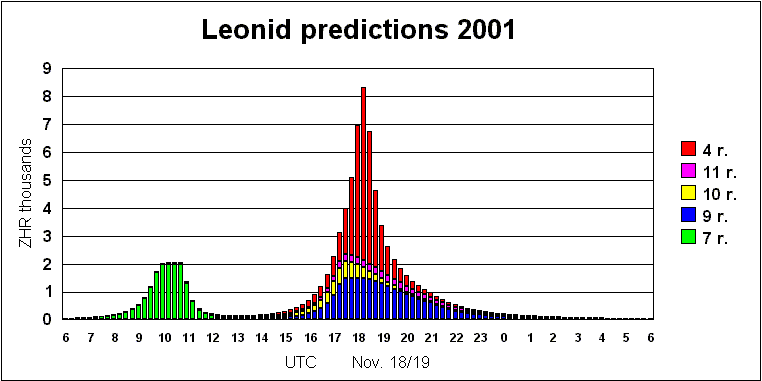Predictions for the Major 2001 Leonid Meteor Storm
(as posted and printed months before the event)
Esko Lyytinen has produced the plot below, showing that some increased meteor activity may be visible over much of the Earth during this excellent storm. We can see at a glance that by far the best activity peak will occur around 18 hours UT on 2001 November 18, and includes contributions from four different meteor streams, pushing the predicted combined rates over 8000 meteors/hour. This will best be seen from the Western Pacific region. Guam island, the site of our planned expedition, will have the radiant of the meteors in the zenith shortly after 18 hours UT!
A secondary peak at about 10 hours UT from a single old meteor trail may produce rates as high as 2000 meteors per hour. The Central U.S. and parts of the Eastern U.S. will be at the right longitude for this peak, and the southern states will have the radiant highest in the sky with the best chances of clear weather.
But even between these peaks, activity may be enhanced, with perhaps 200 meteors/hour over southern Europe because of activity from these trails and from dust trails not shown here. However, these low-activity portions of the trails are not well-constrained, and may produce considerable more or less activity than suggested here.
The best time to view the Leonids from any place on Earth is when the radiant is highest in the sky, which is about 1-2 hours before sunrise (i.e., just before twilight obliterates the meteors). This is about 04h 30m by local "sundial" time (i.e., without adjustment for the time zone you are in). To place yourself on this plot, divide your west longitude by 15 to convert it from degrees to hours (and make it negative if it is an east longitude), then add 4.5 hours. For example, Washington, DC at 77° west longitude would be in the best position at about 5.1+4.5 = 9.6 UT on the plot. From there, the activity peak moves westward as the Earth turns under the meteor streams at 15 degrees every hour. So nine hours later, the activity peak will be over Guam.
To see details about our expedition to observe this magnificent event from Guam, click here.

